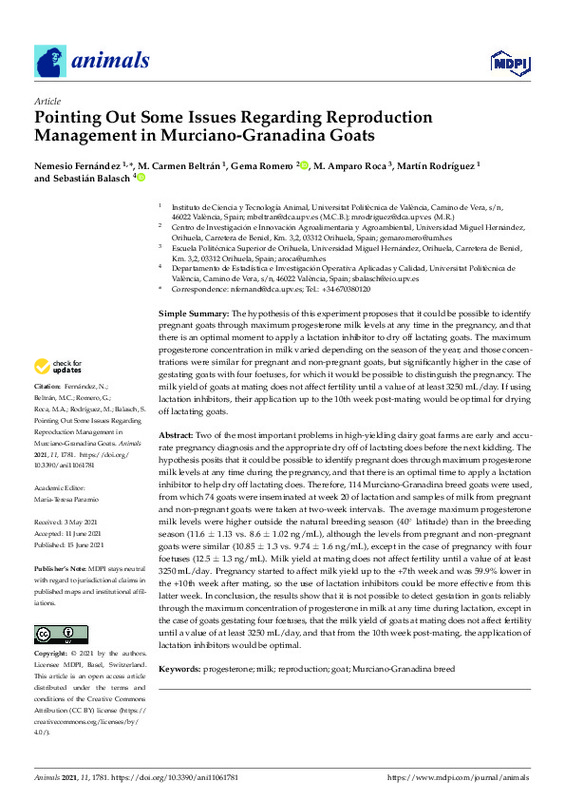JavaScript is disabled for your browser. Some features of this site may not work without it.
Buscar en RiuNet
Listar
Mi cuenta
Estadísticas
Ayuda RiuNet
Admin. UPV
Pointing Out Some Issues Regarding Reproduction Management in Murciano-Granadina Goats
Mostrar el registro sencillo del ítem
Ficheros en el ítem
| dc.contributor.author | Fernández Martínez, Nemesio
|
es_ES |
| dc.contributor.author | Beltrán Martínez, Mª Carmen
|
es_ES |
| dc.contributor.author | Romero, Gema
|
es_ES |
| dc.contributor.author | Roca, M. Amparo
|
es_ES |
| dc.contributor.author | Rodríguez Garcia, Martín
|
es_ES |
| dc.contributor.author | Balasch Parisi, Sebastià
|
es_ES |
| dc.date.accessioned | 2022-04-27T18:06:03Z | |
| dc.date.available | 2022-04-27T18:06:03Z | |
| dc.date.issued | 2021-06 | es_ES |
| dc.identifier.uri | http://hdl.handle.net/10251/182220 | |
| dc.description.abstract | [EN] The hypothesis of this experiment proposes that it could be possible to identify pregnant goats through maximum progesterone milk levels at any time in the pregnancy, and that there is an optimal moment to apply a lactation inhibitor to dry off lactating goats. The maximum progesterone concentration in milk varied depending on the season of the year, and those concentrations were similar for pregnant and non-pregnant goats, but significantly higher in the case of gestating goats with four foetuses, for which it would be possible to distinguish the pregnancy. The milk yield of goats at mating does not affect fertility until a value of at least 3250 mL/day. If using lactation inhibitors, their application up to the 10th week post-mating would be optimal for drying off lactating goats. Two of the most important problems in high-yielding dairy goat farms are early and accurate pregnancy diagnosis and the appropriate dry off of lactating does before the next kidding. The hypothesis posits that it could be possible to identify pregnant does through maximum progesterone milk levels at any time during the pregnancy, and that there is an optimal time to apply a lactation inhibitor to help dry off lactating does. Therefore, 114 Murciano-Granadina breed goats were used, from which 74 goats were inseminated at week 20 of lactation and samples of milk from pregnant and non-pregnant goats were taken at two-week intervals. The average maximum progesterone milk levels were higher outside the natural breeding season (40 degrees latitude) than in the breeding season (11.6 +/- 1.13 vs. 8.6 +/- 1.02 ng/mL), although the levels from pregnant and non-pregnant goats were similar (10.85 +/- 1.3 vs. 9.74 +/- 1.6 ng/mL), except in the case of pregnancy with four foetuses (12.5 +/- 1.3 ng/mL). Milk yield at mating does not affect fertility until a value of at least 3250 mL/day. Pregnancy started to affect milk yield up to the +7th week and was 59.9% lower in the +10th week after mating, so the use of lactation inhibitors could be more effective from this latter week. In conclusion, the results show that it is not possible to detect gestation in goats reliably through the maximum concentration of progesterone in milk at any time during lactation, except in the case of goats gestating four foetuses, that the milk yield of goats at mating does not affect fertility until a value of at least 3250 mL/day, and that from the 10th week post-mating, the application of lactation inhibitors would be optimal. | es_ES |
| dc.description.sponsorship | This research was funded by the project RTA2017-00049-C02-02 (Agencia Estatal de Investigación) with ERDF funds. | es_ES |
| dc.language | Inglés | es_ES |
| dc.publisher | MDPI AG | es_ES |
| dc.relation.ispartof | Animals | es_ES |
| dc.rights | Reconocimiento (by) | es_ES |
| dc.subject | Progesterone | es_ES |
| dc.subject | Milk | es_ES |
| dc.subject | Reproduction | es_ES |
| dc.subject | Goat | es_ES |
| dc.subject | Murciano-Granadina breed | es_ES |
| dc.subject.classification | PRODUCCION ANIMAL | es_ES |
| dc.subject.classification | ESTADISTICA E INVESTIGACION OPERATIVA | es_ES |
| dc.title | Pointing Out Some Issues Regarding Reproduction Management in Murciano-Granadina Goats | es_ES |
| dc.type | Artículo | es_ES |
| dc.identifier.doi | 10.3390/ani11061781 | es_ES |
| dc.relation.projectID | info:eu-repo/grantAgreement/MINECO//RTA2013-00049-C02-02/ES/Selección y mejora de variedades tradicionales de pimiento (Capsicum annuum L.) para rendimiento y calidad de fruto y adaptadas a cultivo ecológico/ | es_ES |
| dc.rights.accessRights | Abierto | es_ES |
| dc.contributor.affiliation | Universitat Politècnica de València. Departamento de Ciencia Animal - Departament de Ciència Animal | es_ES |
| dc.contributor.affiliation | Universitat Politècnica de València. Departamento de Estadística e Investigación Operativa Aplicadas y Calidad - Departament d'Estadística i Investigació Operativa Aplicades i Qualitat | es_ES |
| dc.description.bibliographicCitation | Fernández Martínez, N.; Beltrán Martínez, MC.; Romero, G.; Roca, MA.; Rodríguez Garcia, M.; Balasch Parisi, S. (2021). Pointing Out Some Issues Regarding Reproduction Management in Murciano-Granadina Goats. Animals. 11(6):1-13. https://doi.org/10.3390/ani11061781 | es_ES |
| dc.description.accrualMethod | S | es_ES |
| dc.relation.publisherversion | https://doi.org/10.3390/ani11061781 | es_ES |
| dc.description.upvformatpinicio | 1 | es_ES |
| dc.description.upvformatpfin | 13 | es_ES |
| dc.type.version | info:eu-repo/semantics/publishedVersion | es_ES |
| dc.description.volume | 11 | es_ES |
| dc.description.issue | 6 | es_ES |
| dc.identifier.eissn | 2076-2615 | es_ES |
| dc.identifier.pmid | 34203615 | es_ES |
| dc.identifier.pmcid | PMC8232137 | es_ES |
| dc.relation.pasarela | S\460660 | es_ES |
| dc.contributor.funder | AGENCIA ESTATAL DE INVESTIGACION | es_ES |
| dc.contributor.funder | European Regional Development Fund | es_ES |








